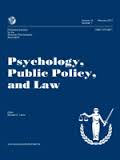 With joint evaluations of CST and MSO, defendants are more likely to be deemed insane and less likely to be deemed incompetent. This is the bottom line of a recently published article in Psychology, Public Policy, and Law. Below is a summary of the research and findings as well as a translation of this research into practice.
With joint evaluations of CST and MSO, defendants are more likely to be deemed insane and less likely to be deemed incompetent. This is the bottom line of a recently published article in Psychology, Public Policy, and Law. Below is a summary of the research and findings as well as a translation of this research into practice.
Featured Article | Psychology, Public Policy, and Law | 2015, Vol. 21, No. 1, 50-59
The Significance of Combining Evaluations of Competency to Stand Trial and Sanity at the Time of the Offense
Author
Preeti Chauhan, John Jay College and the Graduate Center, City University of New York
Janet Warren, University of Virginia
Lauren Kois, John Jay College and the Graduate Center, City University of New York
James Wellbeloved-Stone, University of Virginia
Abstract
Joint evaluations of competency to stand trial (CST) and mental state at the time of the offense (MSO) are common practice and implicitly assumed to be unrelated to evaluators’ psycholegal opinions. To investigate this assumption, the authors used a sample of 5,731 forensic evaluations conducted over a 17-year span to determine (a) the prevalence of joint versus CST-only and MSO-only evaluations; (b) their association with evaluators’ opinions regarding defendants’ competency and/or sanity; and (c) whether referral source, defendant-specific and evaluation characteristics, and psycholegal criteria interact with joint versus referral-specific evaluations in determining evaluators’ opinions. Results indicate that a joint evaluation structure occurred in 54% of the evaluations. Opinions of incompetency were significantly more likely in CST-only relative to joint evaluations. Conversely, opinions of insanity were significantly more likely in joint relative to MSO-only evaluations. Within the joint evaluations, competent and sane was the most frequent opinion. In CST-only evaluations, opinions of incompetency were associated with defendants’ medication noncompliance at the time of the offense, being charged with a nonviolent offense, and the evaluator receiving defendants’ criminal records. These variables were not associated with an incompetency opinion in joint evaluations. In joint evaluations, the absence of prior conviction was related to an opinion of incompetency; this was not the case for CST-only evaluations. The predictors of insanity did not interact with evaluation structure. These findings suggest that the evaluation structure is more important than commonly assumed for forensic practice and may help to inform the clinical practices of evaluators
Keywords
forensic assessment, competency to stand trial, mental state at the time of the offense, insanity, joint evaluations.
Summary of the Research
According to previous research, about one-third of competency to stand trial (CST) and mental state at the time of the offense (MSO) are conducted simultaneously. This article “explores the issue of joint versus referral-specific evaluations to more fully understand if this common practice is irrelevant, as assumed, or if it hides differences in opinion formation that could be of significance to the defendant and the decision making of the courts.” The researchers assumed they would find no differences in opinions of joint or referral-specific evaluations.
“Using 5,731 forensic evaluations conducted from 1990 to 2007, [the authors] examined the frequency of joint evaluations, their relationship to psycholegal opinions, and whether an interaction occurred between predictor variables and opinions of competency and sanity in joint versus referral-specific evaluations. First, [they] examined how often joint versus CST-only or MSO-only evaluations occur and whether the evaluation structure is related to an opinion of competency and sanity. Next, [they] assessed the amount of overlap between competency and sanity opinions in joint evaluations. Last, [they] investigated whether referral source, defendant-specific and evaluation characteristics, and types of psycholegal impairment influenced opinions of incompetency or insanity by evaluation structure (i.e., joint or referral-specific evaluations).” The researchers found a dual use of CST and MSO occurred in 54% of evaluations.
For a majority of evaluations, “the evaluator received the warrant (84.9%), official offense information (76.7%), reason for the evaluation (87.4%), psychological and medical records (62.7%), and the defendant’s statement (66.1%). However, only a small percentage received witnesses’ statements (36.3%), and about half received the defendant’s criminal record (46.5%). Only a small percentage of evaluations involved psychological testing (16.4%). In terms of time spent, the average evaluation was 7.77 hr with 2.47 hr spent on the interview, 1.77 hr spent on information gathering, and 3.49 hr on report writing.”
Overall, the researchers’ expectation that no differences would be found between CST-only and joint assessment was unfounded. “Defendants [were] less likely to be found incompetent in the context of a joint evaluation as compared with a CST-only assessment and more likely to be found insane in the context of a joint evaluation as contrasted to a MSO-only evaluation.” The majority of the defendants (87.8%) in the sample that had dual evaluations were deemed both competent to stand trial and sane. In joint evaluations, individuals were less likely to be deemed competent if they did not have a prior criminal conviction. Offense type, medication compliance, and receiving criminal records were not significant factors in regards to competency opinions in joint evaluations.
Translating Research into Practice
The authors highlight ethical concerns surrounding consent when the individual is deemed incompetent, indicating that consent for the sanity evaluation might too easily be swept under the umbrella of court-sanctioned evaluation to stand trial. CST opinions are more likely than MSO to be in line with the court’s final decision regarding an individual. Depending on the laws and practices in an evaluators jurisdiction, evaluators should still make efforts to ensure consent is given in legal and ethical terms. For some situations, “evaluators should not proceed with an evaluation of MSO if the defendant is incompetent, but these data suggest that they often do. Indeed, in about 87% of the cases, evaluators offered an opinion of MSO even though the defendant was incompetent.” It is important, however, to tease apart the issue of (in)competence to stand trial and (in)competence to consent to the evaluation process so care should be taken to make this distinction in those cases where the evaluator holds the opinion that the defendant is incompetent to stand trial.
In joint evaluations where the evaluator deemed the individual incompetent, “evaluators spent less time writing the report and on the overall evaluation. In contrast, in the CST-only evaluations, defendants were more often opined incompetent if they were charged with a nonviolent offense, were non-compliant with their medication at the time of the offense, and if the evaluator did not have access to criminal records. These relationships were not present for joint evaluations. Taken broadly, these differences underscore the importance of the evaluation structure in competency opinions. Notably, these differences across evaluation contexts did not include the primary clinical variables, suggesting that criminogenic and process variables are central to these differences in evaluation structure. Further, the CST-only evaluations seem to primarily capture the chronically mentally ill defendants who have been prescribed medication but are non-compliant in taking it and who are charged with minor and nonviolent offenses.” This statement should underscore for evaluators the importance of retaining objectivity and attention to detail. It also articulates the challenge and necessity for evaluators to gather complete information for the individuals they evaluate.
“Within [this] data set, joint evaluations were less likely to lead to an opinion supportive of incompetency but more likely to lead to an opinion supportive of insanity. These findings should alert researchers to the significance of this structural component of forensic evaluation, which could mask important differences in competency or sanity evaluation outcomes.”
Other Interesting Tidbits for Researchers and Clinicians
The authors suggested that the intentions of attorneys play a role in the evaluation outcome. “Attorneys who refer defendants for joint, relative to CST-only, evaluations may be primarily looking for mitigating factors to assist in plea bargaining. Conversely, attorneys who referred defendants for CST-only evaluations may be expressing true concerns about the defendant’s capacity to proceed to trial.”
Join the Discussion
As always, please join the discussion below if you have thoughts or comments to add!























